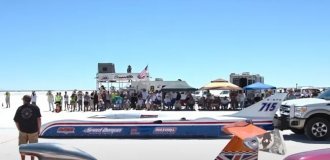Beckman - custom project based on Izh-Jupiter (38 photos)
On the eve of the World Customizing Championship - AMD World & European Championship of Custombike Building - 2016, we present a project from the Iron Custom Motorcycles workshop - about the Beckman custom from first-hand.
“Background: after the last World Championship, where we took 4th place in the street performance class, we decided to implement a project based on our national motorcycle, so that the world public would learn about our roots, and not be limited to the brands Harley Davidson, Triumph, Ducat, Norton, BSA, BMW, etc. For this, we chose the most iconic motorcycle, Izh-Jupiter, which not only our fathers and grandfathers rode, but us too!!! And so the Beckman custom project was born!!! ?The Beckman project represents a vision of a café racer that could have been built by our country's enthusiasts in the late 70s and early 80s. In creating this project, we decided to use only spare parts from the 60-80s, available in our country, home-made components and production technologies for parts from this period.

Wilhelm Beckmann is an outstanding athlete and design engineer, author of a large number of books on motorsports and motorcycle design. It was based on his books and articles that this motorcycle was built, conveying the spirit and era of that time. The motorcycle is built on the basis of the Izh-Jupiter 4, produced in 1982, but there are no stock parts left on it. The original engine has 2 cylinders and a power of 28 hp / 5600 rpm, which naturally did not suit us. We decided to realize the most daring dream of a motorbike enthusiast and build a homemade three-cylinder engine, which would provide the necessary power for a cafe racer, compactness and light weight.

We carried out a huge list of work on the engine:
• We made a homemade crankcase from three parts (based on Izh Jupiter 4)
• Made a crankshaft with 70% lighter flywheels
• The cylinders (Izh Jupiter 4) were seriously modernized: they were bored for a 64 mm piston, they were seated in height by 12 mm, the channels and windows were expanded by 30% (5 purge channels, 1 - inlet, 1 - exhaust), phase 175 degrees, compression ratio 12. Middle cylinder with increased thermal clearance. Manufactured and installed housings for reed valves – Yamaha banshee 350
• The combustion chambers in the cylinder heads have been changed: side cylinder heads - IZH Jupiter 3, central - IZH Jupiter 5
• All bearings are oversized
• Connecting rods - converted from ChZ-250, Yamaha RD-350 pistons
• 4-speed gearbox – modernized from IZH Sh-12, with an extended shaft
• Homemade ceramic clutch
• Ignition system – electronic, contactless; designed specifically for this motor.
• Three Mikuni VM26 carburetors, with homemade throttle drive

As a result, we got an engine capacity of 555 cc and a power of more than 50 hp. at 7500 rpm. We will check the exact value on the dyno after running in. Separately, we would like to highlight our exhaust system - this is the “visually main” detail of the entire project. Not only does it look chic, handmade from stainless steel, but it is also designed for this homemade engine and provides a good “middle”, which a regular two-stroke does not have. Since the new engine is wider, we took the Jawa350 typ 634 frame and completely rebuilt the rear end. The frame became stronger and received a café “line”. The pendulum is homemade, made for installing a monoshock absorber, which is located parallel to the ground and works through a system of levers. This design gained popularity in the 70s in Moto GP. The front fork is a rare short-lever fork from the K-750 motorcycle (late 50s - early 60s of the last century), which was converted for installation in this frame. Homemade clip-ons are welded to the upper yoke, like on racing motorcycles 60-70xx. A retro damper is also installed, working on the principle of friction - a symbiosis of the damper from the Izh-49 and M-72. We installed the coolest wheels for that period - from IZH Sh-12 - two-piston drums, which we modified: we increased the cooling of the brakes and lengthened the rear hub. We also chose authentic tires - Firestone Deluxe Champion, size 450-18.

Now about the body kit, in which we also used many interesting technical solutions. The tank is completely homemade, has a double bottom and holes for ventilation of the lower section. In combination with adhesive thermal protection, this is designed to protect the fuel from overheating. In addition, three fuel taps are installed separately in the tank - individually for each carburetor. We gave Baku the shapes characteristic of that period - “square-rounded”, with some molded curves. The rear fairing “tail” is a stylistic continuation of the tank, has a “line” characteristic of a cafe racer and ends with a lamp from a GAZ-51 car; the electrics are located inside. The seat is homemade, covered with thermal vinyl, as are the handles, footrests, motorcycle triggers, and the kickstarter leg. Three lines on the seat are a development of the “concept of three” - three cylinders, resonators, carburetors. The colors of the stitching are also selected to match the overall concept of the cafe. The front fairing is also a homemade element that performs the aerodynamic function of glass and is the housing of a vintage headlight and dashboard. The tidy is as simple as possible - a speedometer from an Izh-49 motorcycle and an ignition switch. All other elements were dismantled as unnecessary and to reduce weight. Lower fairing – protects the motorcycle engine, shock absorber and battery when driving off-road. Also has vents to cool the motor and reduce weight.

The color scheme of the motorcycle is a complex combination of vintage shades of green and red, diluted with polished aluminum elements of the engine, wheels and copper parts. The aesthetics of the color and character of the motorcycle are complemented by engravings made in the style of Soviet constructivism. The engravings are made by hand, the materials used are aluminum and copper.

To minimize the weight and charisma of a cafe racer, all “unnecessary” elements were removed from the motorcycle: turns, mirrors, center stand, starter, electrical elements, etc. The maximum speed of the motorcycle is about 200 km/h. We present the Beckman project in the Cafe Racer class at AMD-2016 and hope for a good result!!!





















































